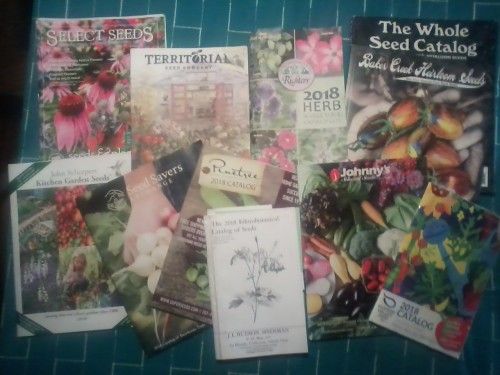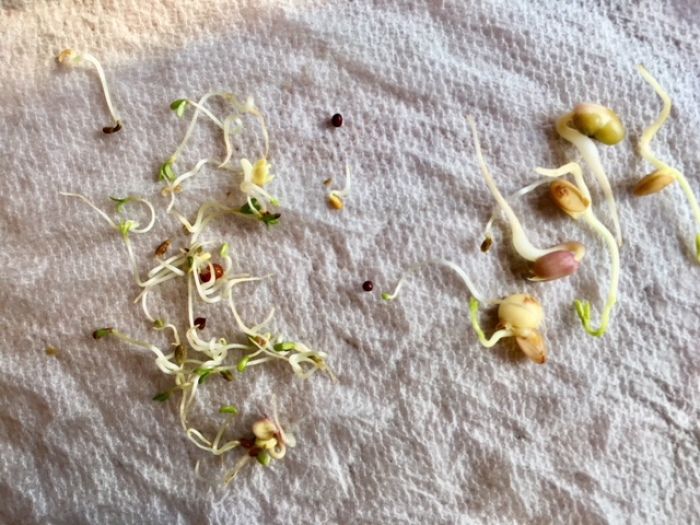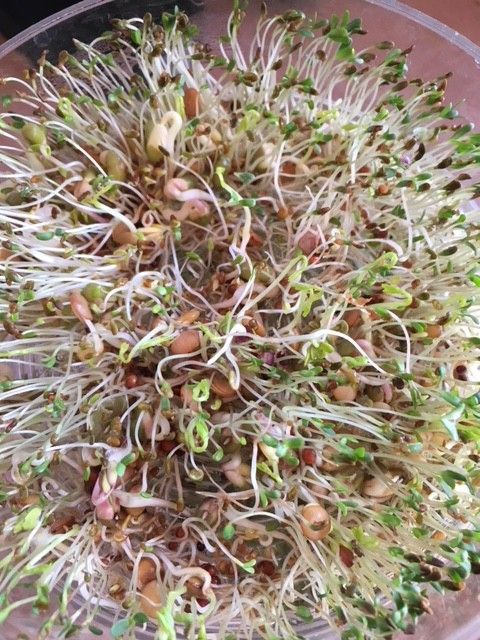
If you haven’t ordered your garden seeds for 2018, now is the time. As I sit by the woodstove looking out on another grey, cold day, the precipitation is coming down heavily. It started out as freezing rain, now it is rain and once the temps start to drop this afternoon, who knows what it will turn to? The back porch steps, the deck and even spots on the packed gravel drive are like a skating rink-so I am not going anywhere.
What better time to sit by the stove and finalize the seed orders… or at least a few them? Just the thought of that, plus my delicious hot drink of cacao with medicinal mushrooms, vanilla and a touch of maple syrup to sweeten, cheer me. Just as soon as I finish this blog, I will move from laptop to armchair…
Over the years, I have written numerous blogs before about sowing seed.
/item/10440/sowing-seeds-for-salad-in-flats
/item/13405/sow-your-own-annual-herbs
Choosing seed for the next garden is a creative pleasure for me-a little bit of work, combined with thoughtful planning, spurred by imagination and some daydreaming of a garden-to-be in warm sunny weather. Also, we gardeners need to keep in mind, the seed packs left over from last year, our own seeds that we harvested and dried, not to mention our pocketbooks. (Funny, this is not a word I use often- according to Merriam Webster, it has two meanings: 1. the amount of money that someone has available to spend 2. A bag usually with handles and pockets that is used by women to carry money and personal belongings–my kids made fun of me for years for using such an antiquated term for purse. Its first use was 1617 and that is what my grandmother always called her handbag.) Oops, I got distracted there… I love words… and I love seeds!
Here is a lovely quote from a recent post on herbalist Maia Toll’s blog https://maiatoll.com/inspiration/
“A seed is a gorgeous thing in and of itself, isn’t it? The hard outer shell can take a myriad of shapes, from the gentle curling of a calendula seed to the hard husk of a black walnut. Inside that exterior covering is a dense nutrient core. A seed is kind of like a spaceship: everything needed to survive in a hostile environment is contained within.”
There are such tiny seeds that they have to put them in tiny envelopes inside of regular seed packs. And then there are some big hunky seeds like nasturtiums that are nearly the size of a garbanzo bean. Of course, beans and squash and peas are pretty hefty in size and beans can be beautifully mottled in color depending upon the variety. For appearance, I love the stripey black and white sunflower seeds, the crescent-shaped, tentacled-look of calendula seeds and the knobby, alien-appearance of beet seeds.
I sprout seeds on my kitchen countertop throughout the year, however most especially in the winter, when I am craving green growing things. /item/60530/countertop-grow-your-own
This is a similar process to checking out your last year’s seed to see if it is viable. Big growers often do a hot water process and sometimes with a low percentage of bleach with expensive equipment to test seeds viability and germination rate as well as a prevention for diseases. We home gardeners do not have access to such equipment, so we can sprout a few each of our older seeds by keeping them moist in a damp paper towel to see if they sprout. Or some green thumb gardeners I know just sow the saved seed and hope for the best-if it doesn’t germinate-then they sow another kind of seed in its place.
This quote by Cynthia Occelli was also found on Maia Toll’s blog:
“For a seed to achieve its greatest expression, it must come completely undone. The shell cracks, its insides come out and everything changes. To someone who doesn’t understand growth, it would look like complete destruction.”
Sometimes, we get old seeds to sprout, other times the germination might be very low. One is more likely to have success, if the seeds have been stored in jars or an air-tight container in a cool environment away from sun and humidity.
I find that John Scheepers’ Kitchen Garden Seeds catalog is very informative and is very handy in that it lists the average seed life that seeds can be kept under each vegetable entry. For instance, mache and arugula seeds are good for about one year, chile peppers can be kept for two years, and brassica family and peas are good for up to three years. Check out the catalog online (https://dynalog.catalogs.com/catalogs/24086/pdf) or ask them to send you a paper copy.
I have written about Hudson Valley Seed Company in previous blogs because I love how they combine seed saving with art and I am a sucker for their unique Art Packs. I find the latter delightful and often send them as gifts (check out their gift cards that you can insert the packs into-very cool).
I signed up awhile back to receive their blog and I recommend doing so-they send sale info every now and then-however their blogs have good info. There is a recent, timely one titled “Seed-Trade Secrets: Your Old Seeds Might Still Grow” which gives good details on “Germ Testing” at home-check it out. https://hudsonvalleyseed.com/blog/seed-trade-secrets-your-old-seeds-might-still-grow/?utm_source=Hudson+Valley+Seed+Company+E-Mail+List&utm_campaign=6cf9288efe-MAIL_CAMPAIGN_2018_01_10&utm_medium=email&utm_term=0_bb3d09aa7e-6cf9288efe-186638569
“Each seed carries invisible, yet indelible, finger prints on its seed coat. Each leaf or fruit is a gift from a long line in seed savers.” —www.hudsonvalleyseed.com
Now is the time to take stock and do your germ testing of the seeds that you may have saved over the last few years. Better get those seeds ordered since it is already February and it won’t be long now before we start sowing those seeds!




















Comments
Log in or create an account to post a comment.
Sign up Log in